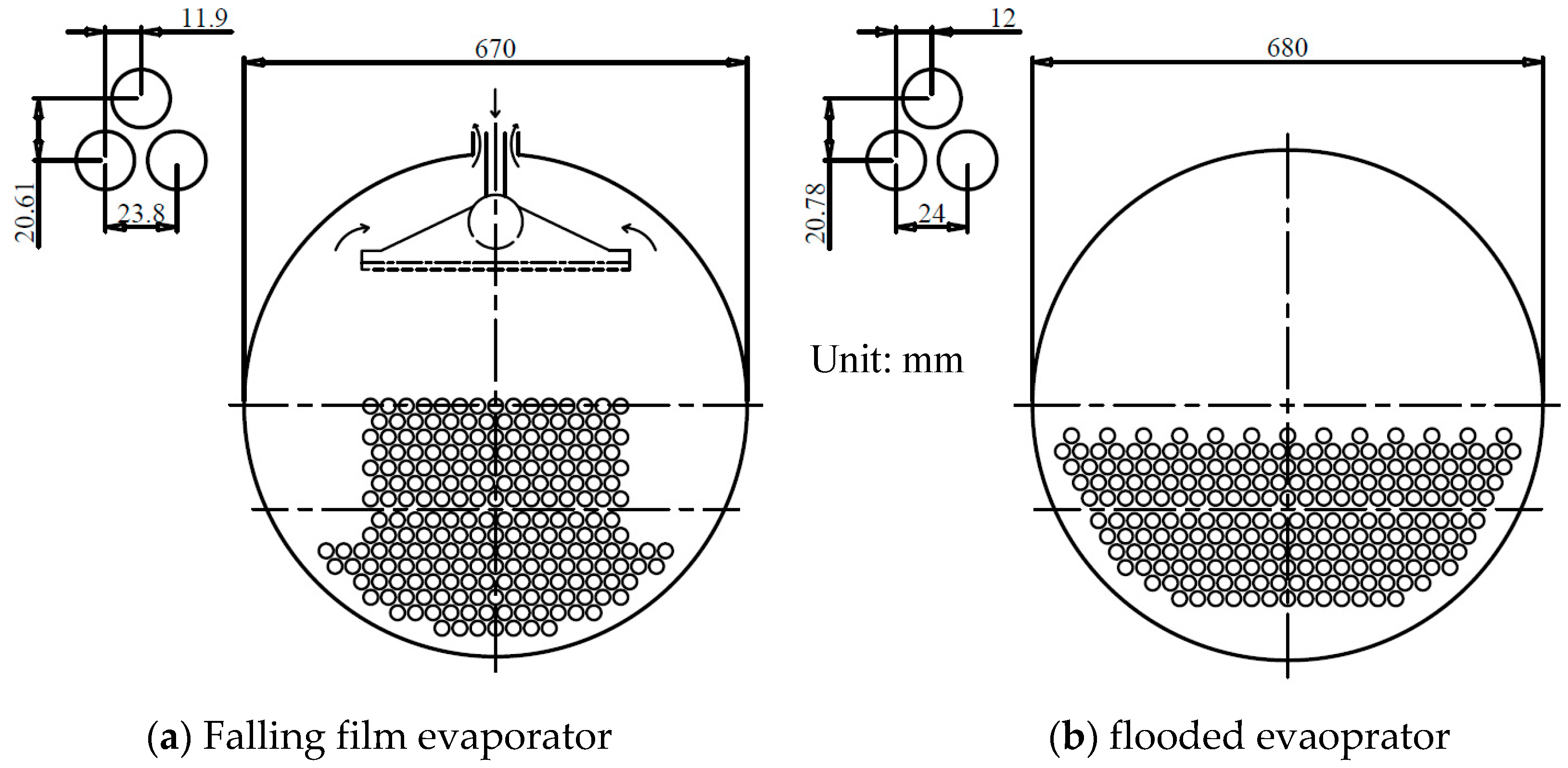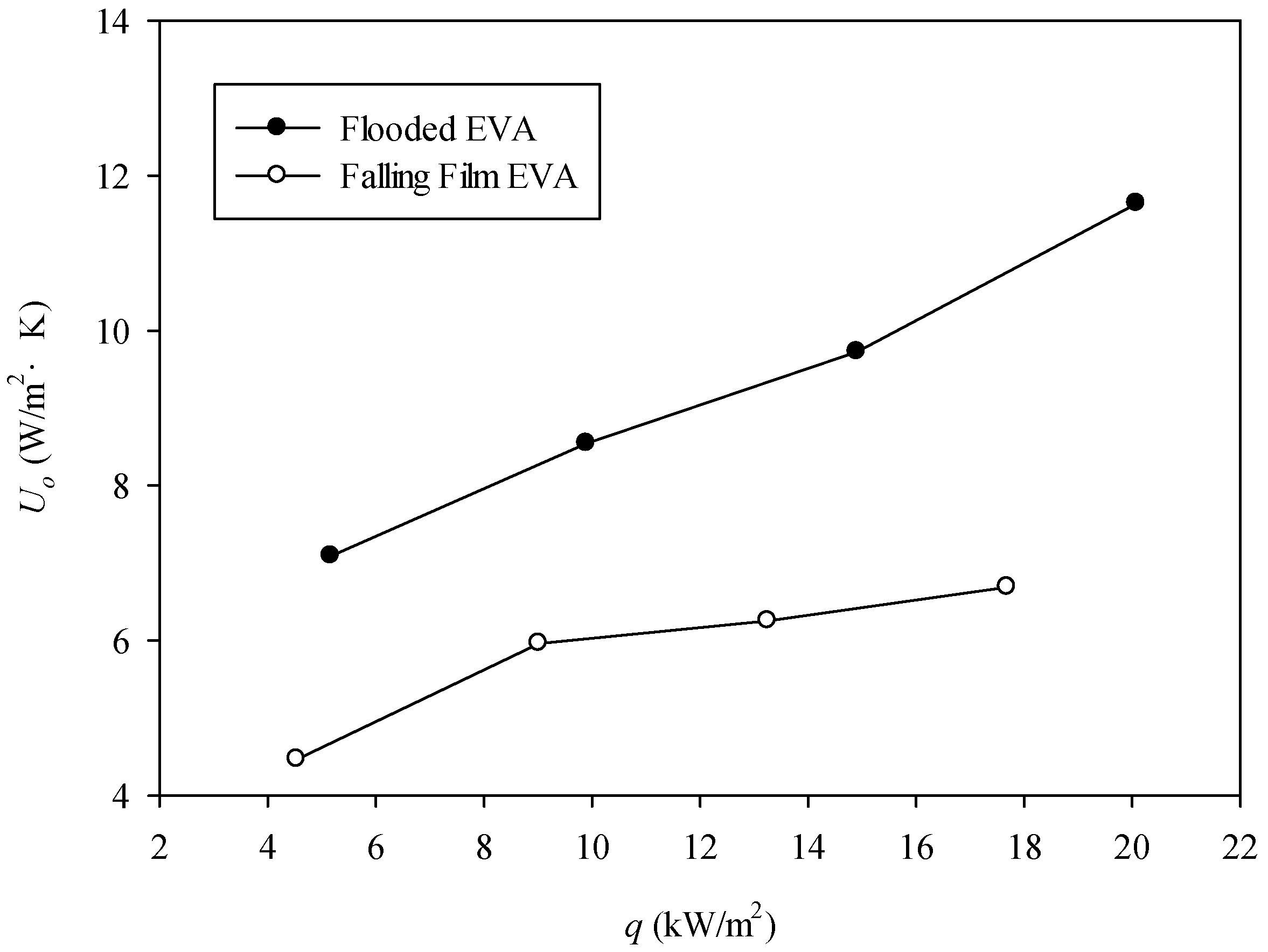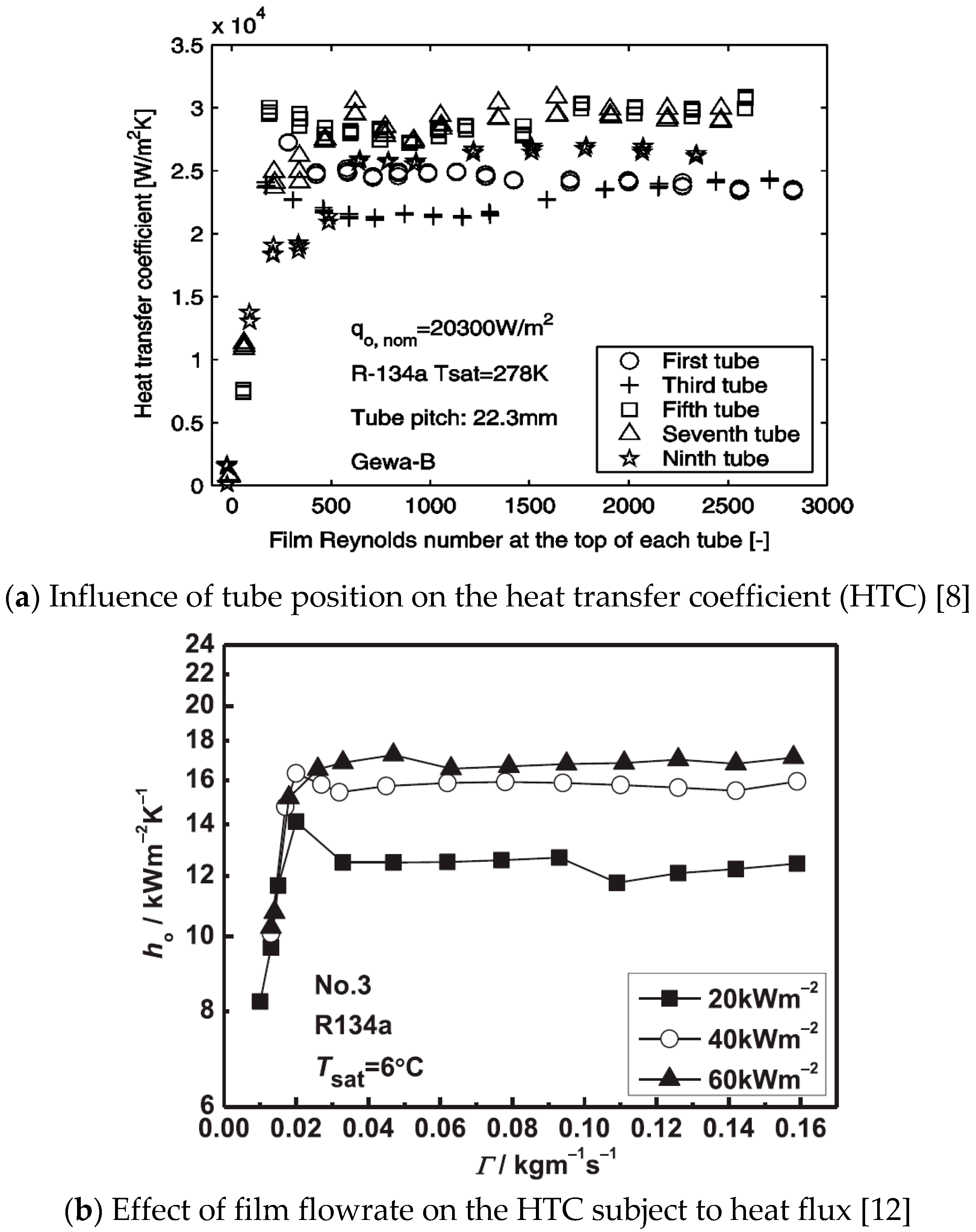A Comparative Study of the Oil-Free Centrifugal Water Chillers with the Flooded or Falling Film Evaporator—A Case Study
Abstract
1. Introduction
2. Experimental Setup and Data Reduction for System Performance
2.1. Introduction to the Experimental Setup
2.2. Experimental Apparatus and Measurements
- Chilled water flowrate at the evaporator: the flowrate at full-load operation for both chillers is regulated to achieve a fixed temperature difference of chilled water across the evaporator (5 °C, with tolerance being less than 0.3 °C). The required water flowrate is about 10 LPM per USRT (2.84 LPM per kW).
- Cooling water flowrate at the condenser: the flowrate at full-load operation for both chillers is regulated to achieve a fixed temperature difference of cooling water across the condenser (5 °C, with tolerance being less than 0.3 °C). The required water flowrate is about 12.5 LPM per USRT (3.56 LPM per kW).
- Outlet temperature of the chilled water: the temperature is required to be maintained at 7 °C with 0.3 °C tolerance.
- Inlet temperature of the cooling water: tests are conducted in different loading conditions (100%, 75%, 50% and 25%). The corresponding temperatures to arrive at the loading are 30 °C, 24.5 °C, 19.0 °C, and 19.0 °C, respectively, with a tolerance of 0.3 °C.
2.3. Data Reduction of the Experimental Measurements
3. Results and Discussion
4. Conclusions
- Both chillers reveal an appreciable drop of capacity and compressor power when the compressor revolution is reduced but the corresponding COP rises when the loading is reduced, and it reaches the plateau at 50% part-load with a COP of around 9.9. A further un-loading to 25% leads to a detectable decline of COP.
- The system performance in terms of IPLV for the falling film evaporator is 8.627 and it is 8.634 for the flooded evaporator, implying a comparable performance between the falling film evaporator and the flooded evaporator.
- The overall heat transfer coefficient for the flooded evaporator is appreciably higher than the falling film evaporator by up to 40%. The results do not agree with typical test results on falling film evaporators and flooded evaporators. This is because the falling film flowrate is below the threshold value and the heat transfer is dominated by the evaporation mode. Yet, the heat transfer performance for the falling film evaporator can be further jeopardized due to starvation of the film flowrate (partial dry-out), since the present film flowrate may fall below the threshold critical film flowrate, especially in the middle or bottom of the tube bundle. This phenomenon becomes even more pronounced at partial loading (25%), while the flooded evaporator did not reveal such performance dip at partial loading.
Author Contributions
Funding
Conflicts of Interest
Nomenclature
| A, B, C, D | A is coefficient of performance (COP) at 100% load, B is the COP at 75% load, C is the COP at 50% load, and D is the COP at 25% load. From Equation (1), the proportions of 75% and 50% part-loads are much higher than full load or 25% load. |
| Ai | inner surface area of the enhanced tube (m2) |
| Ao | outer surface area of the enhanced tube (m2) |
| C0, C1,C2 | correlation constant in Equation (9) |
| (kW/K) | |
| COP | coefficient of performance |
| specific heat of chilled water (kJ/kg·K) | |
| Di | inner tube diameter (m) |
| Do | outer tube diameter (m) |
| Gt-s | tube specific number |
| hi | tube side heat transfer coefficient (W/m2·K) |
| ho | shell side heat transfer coefficient (W/m2·K) |
| hlv | latent heat of evaporation (kJ/kg) |
| k | thermal conductivity (W/m·K) |
| L | tube length (m) |
| chilled water mass flowrate at the evaporator (kg/s) | |
| NTU | number of transfer unit |
| q | heat flux (kW/m2) |
| heat transfer rate at the evaporator (kW) | |
| maximum heat transfer rate at the evaporator (kW) | |
| Re | Reynolds number |
| inlet water temperature of the chilled water (K) | |
| saturation temperature at the evaporator (K) | |
| U | overall heat transfer coefficient (W/m2·K) |
| Wcomp | compressor power (kW) |
| temperature difference of chilled water across evaporator (K) | |
| ε | effectiveness of the heat exchanger |
| Γ | liquid flow rate on one side of the tube per unit length (kg/m·s) |
| μ | viscosity (Pa·s) |
References
- Hung, K.-S.; Chung, J.-C.; Liu, C.-C.; Huang, J.-M. A study of off-design performance improvement for a centrifugal refrigerant compressor. Adv. Mech. Eng. 2017, 9. [Google Scholar] [CrossRef]
- Air-Conditioning, Heating, and Refrigeration Institute (AHRI). Performance Rating of Water-chilling and Heat Pump Water-heating Packages Using the Vapor Compression Cycle. In ANSI/AHRI STANDARD 551/591 (SI)-2018; AHRI: Arlington, VA, USA, 2018. [Google Scholar]
- Yu, F.W.; Chan, K.T.; Sit, R.K.Y. Analysis of centrifugal chillers with oil-free magnetic bearings for enhancing building energy performance. Sci. Technol. Built Environ. 2017, 23, 334–344. [Google Scholar] [CrossRef]
- Yu, F.W.; Chan, K.T.; Sit, R.K.Y.; Yang, J. Performance Evaluation of Oil-free Chillers for Building Energy Performance Improvement. Procedia Eng. 2015, 121, 975–983. [Google Scholar] [CrossRef]
- Lissandrin, M.; Rampazzo, M.; Cecchinato, L.; Beghi, A. Optimal operational efficiency of chillers using oil-free centrifugal compressors. Int. J. Refrig. 2017, 82, 83–96. [Google Scholar] [CrossRef]
- Wang, C.-C.; Hafner, A.; Kuo, C.-S.; Hsieh, W.-D. An overview of the effect of lubricant on the heat transfer performance on conventional refrigerants and natural refrigerant R-744. Renew. Sustain. Energy Rev. 2012, 16, 5071–5086. [Google Scholar] [CrossRef]
- Wang, C.-C.; Hafner, A.; Kuo, C.-S.; Hsieh, W.-D. Influence of Lubricant on the Nucleate Boiling Heat Transfer Performance of Refrigerant—A Review. Heat Transf. Eng. 2014, 35, 651–663. [Google Scholar] [CrossRef]
- Roques, J.F.; Thome, J.R. Falling Films on Arrays of Horizontal Tubes with R-134a, Part I: Boiling Heat Transfer Results for Four Types of Tubes. Heat Transf. Eng. 2007, 28, 398–414. [Google Scholar] [CrossRef]
- Roques, J.F.; Thome, J.R. Falling Films on Arrays of Horizontal Tubes with R-134a, Part II: Flow Visualization, Onset of Dryout, and Heat Transfer Predictions. Heat Transf. Eng. 2007, 28, 415–434. [Google Scholar] [CrossRef]
- Habert, M.; Thome, J.R. Falling-Film Evaporation on Tube Bundle with Plain and Enhanced Tubes—Part I: Experimental Results. Exp. Heat Transf. 2010, 23, 259–280. [Google Scholar] [CrossRef]
- Habert, M.; Thome, J.R. Falling-Film Evaporation on Tube Bundle with Plain and Enhanced Tubes—Part II: New Prediction Methods. Exp. Heat Transf. 2010, 23, 281–297. [Google Scholar] [CrossRef]
- Zhao, C.-Y.; Jin, P.-H.; Ji, W.-T.; He, Y.-L.; Tao, W.-Q. Experimental investigations of R134a and R123 falling film evaporation on enhanced horizontal tubes. Int. J. Refrig. 2017, 75, 190–203. [Google Scholar] [CrossRef]
- Jin, P.-H.; Zhao, C.-Y.; Ji, W.-T.; Tao, W.-Q. Experimental investigation of R410A and R32 falling film evaporation on horizontal enhanced tubes. Appl. Therm. Eng. 2018, 137, 739–748. [Google Scholar] [CrossRef]
- Ji, W.-T.; Zhao, C.-Y.; Zhang, D.-C.; Yoshioka, S.; He, Y.-L.; Tao, W.-Q. Effect of vapor flow on the falling film evaporation of R134a outside a horizontal tube bundle. Int. J. Heat Mass Transf. 2016, 92, 1171–1181. [Google Scholar] [CrossRef]
- Van Rooyen, E.; Thome, J.R. Flow boiling data and prediction method for enhanced boiling tubes and tube bundles with R-134a and R-236fa including a comparison with falling film evaporation. Int. J. Refrig. 2014, 41, 60–71. [Google Scholar] [CrossRef]
- Yang, L.; Wang, W. The heat transfer performance of horizontal tube bundles in large falling film evaporators. Int. J. Refrig. 2011, 34, 303–316. [Google Scholar] [CrossRef]
- Yang, L.; Song, X.; Xie, Y. Effect of the Dryout in Tube Bundles on the Heat Transfer Performance of Falling Film Evaporators. Procedia Eng. 2017, 205, 2176–2183. [Google Scholar] [CrossRef]
- Ribatski, G.; Jacobi, A.M. Falling-film evaporation on horizontal tubes—A critical review. Int. J. Refrig. 2005, 28, 635–653. [Google Scholar] [CrossRef]
- Christians, M.; Thome, J.R. Falling film evaporation on enhanced tubes, part 2: Prediction methods and visualization. Int. J. Refrig. 2012, 35, 313–324. [Google Scholar] [CrossRef]
- Van Rooyen, E.; Thome, J.R. Pool boiling data and prediction method for enhanced boiling tubes with R-134a, R-236fa and R-1234ze(E). Int. J. Refrig. 2013, 36, 447–455. [Google Scholar] [CrossRef]
- Christians, M.; Thome, J.R. Falling film evaporation on enhanced tubes, part 1: Experimental results for pool boiling, onset-of-dryout and falling film evaporation. Int. J. Refrig. 2012, 35, 300–312. [Google Scholar] [CrossRef]




| Type of Evaporator | Falling Film EVA | Flooded EVA | ||||||
|---|---|---|---|---|---|---|---|---|
| Loading | 100% | 75% | 50% | 25% | 100% | 75% | 50% | 25% |
| EEV opening (%) | 56 | 43 | 33 | 20 | 93 | 60 | 48 | 37 |
| Inverter frequency (Hz) | 605 | 517 | 428 | 408 | 625 | 535 | 439 | 417 |
| Rpm | 18,150 | 15,510 | 12,840 | 12,240 | 18,750 | 16,050 | 13,170 | 12,510 |
| Compression ratio | 2.49 | 2.00 | 1.63 | 1.56 | 2.52 | 2.04 | 1.64 | 1.57 |
| Capacity (USRT) | 198.7 | 149.0 | 101.4 | 51.0 | 229.9 | 169.3 | 112.2 | 58.6 |
| Capacity (kW) | 698.7 | 524.0 | 356.5 | 179.3 | 808.5 | 595.1 | 394.5 | 206.1 |
| Suction pressure (bar, gage) | 2.62 | 2.65 | 2.69 | 2.69 | 2.61 | 2.63 | 2.67 | 2.68 |
| Discharge pressure (bar, gage) | 8.05 | 6.3 | 5.03 | 4.75 | 8.12 | 6.41 | 5.02 | 4.77 |
| Chilled water flowrate (LPM) | 2018 | 2018 | 2018 | 2018 | 2322 | 2322 | 2322 | 2322 |
| Inlet temperature Chilled water (°C) | 12.3 | 11.0 | 9.8 | 8.5 | 12.1 | 10.7 | 9.6 | 8.3 |
| Outlet temperature Chilled water (°C) | 7.3 | 7.3 | 7.3 | 7.2 | 7.2 | 7.1 | 7.1 | 7.1 |
| Cooling water flowrate (LPM) | 2551 | 2551 | 2551 | 2551 | 2796 | 2796 | 2796 | 2796 |
| Inlet temperature Cooling water (°C) | 29.8 | 23.9 | 18.9 | 18.8 | 29.8 | 24.5 | 19.1 | 18.9 |
| Outlet temperature Cooling water (°C) | 34.4 | 27.2 | 21.1 | 19.9 | 34.4 | 27.9 | 21.3 | 20.1 |
| COP | 5.54 | 7.51 | 9.94 | 7.87 | 5.58 | 7.35 | 9.99 | 8.3 |
| Power (kW) | 126.08 | 69.77 | 35.86 | 22.79 | 144.9 | 80.97 | 39.15 | 24.85 |
| Evaporation pressure (bar, gage) | 2.66 | 2.67 | 2.70 | 2.68 | 2.72 | 2.70 | 2.71 | 2.71 |
| Evaporation Temperature (°C) | 6.4 | 6.5 | 6.7 | 6.7 | 6.9 | 6.7 | 6.8 | 6.8 |
| Condensing pressure (bar, gage) | 7.99 | 6.19 | 4.97 | 4.72 | 7.81 | 6.32 | 5.00 | 4.77 |
| Condensing Temperature (°C) | 35.2 | 27.5 | 21.3 | 20.0 | 34.5 | 28.1 | 21.5 | 20.2 |
| Discharge Temperature (°C) | 42.6 | 33.4 | 25.9 | 25.9 | 42.7 | 34.1 | 26.0 | 26.3 |
© 2019 by the authors. Licensee MDPI, Basel, Switzerland. This article is an open access article distributed under the terms and conditions of the Creative Commons Attribution (CC BY) license (http://creativecommons.org/licenses/by/4.0/).
Share and Cite
Hung, K.-S.; Chung, J.-C.; Liu, C.-C.; Lin, J.-J.; Wang, C.-C. A Comparative Study of the Oil-Free Centrifugal Water Chillers with the Flooded or Falling Film Evaporator—A Case Study. Energies 2019, 12, 2548. https://doi.org/10.3390/en12132548
Hung K-S, Chung J-C, Liu C-C, Lin J-J, Wang C-C. A Comparative Study of the Oil-Free Centrifugal Water Chillers with the Flooded or Falling Film Evaporator—A Case Study. Energies. 2019; 12(13):2548. https://doi.org/10.3390/en12132548
Chicago/Turabian StyleHung, Kuo-Shu, Jenn-Chyi Chung, Chung-Che Liu, Jun-Jie Lin, and Chi-Chuan Wang. 2019. "A Comparative Study of the Oil-Free Centrifugal Water Chillers with the Flooded or Falling Film Evaporator—A Case Study" Energies 12, no. 13: 2548. https://doi.org/10.3390/en12132548
APA StyleHung, K.-S., Chung, J.-C., Liu, C.-C., Lin, J.-J., & Wang, C.-C. (2019). A Comparative Study of the Oil-Free Centrifugal Water Chillers with the Flooded or Falling Film Evaporator—A Case Study. Energies, 12(13), 2548. https://doi.org/10.3390/en12132548





